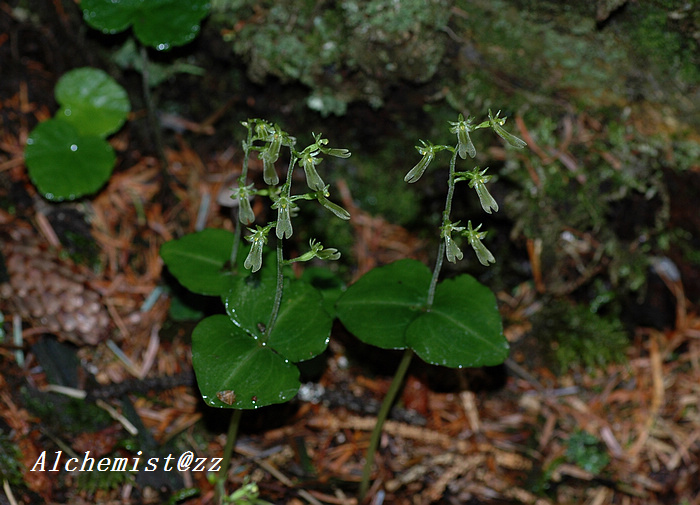- Scientific Name: Neottia puberula (Maxim.) Szlach.
- Ref: Fragm. Florist. Geobot., Suppl. 3:118. 1995
- Synonym: Listera puberula Maxim.
- Chinese Common Name: 对叶兰 duìyè∙lán
- Japanese Common Name: タカネフタバラン [高嶺双葉蘭] takanefutabaran
- Family: Orchidaceae
- Genus: Neottia
- Distribution: Damp places in dense forests, deep shade of coniferous forests; 1400-2600 m. Chongqing, C and S Gansu, Guizhou, NW Hebei, Heilongjiang, S Jilin, Liaoning, Nei Mongol, Qinghai, N Shanxi, N and NW Sichuan [Japan, Korea, Russia (Far East)].
- Photo: Mt. Changbai, Jilin
Plants autotrophic, 8-20 cm tall. Rhizome with very few elongate, filiform roots. Stem cylindric, slender, usually with 1 or 2 membranous sheaths toward base. Leaves 2, opposite, borne at ca. middle of plant, subsessile, cordate, broadly ovate, or broadly ovate-triangular, 1.5-2.5 × 1.5-2.2 cm, base broadly cuneate or subcordate, margin slightly crisped, apex acute or obtuse. Peduncle 2-7 cm, pubescent; rachis 2.5-7 cm, pubescent, laxly 4-7-flowered; floral bracts lanceolate, 1.5-3.5 mm, glabrous, apex acute. Flowers very small, resupinate, green; pedicel 3-4 mm, pubescent; ovary ca. 6 mm, pubescent; sepals and petals not spreading widely. Dorsal sepal ovate-lanceolate, 1.8-2.4 × 0.8-1 mm, 1-veined, apex subacute; lateral sepals ovate-lanceolate, oblique, 1.5-2.2 × ca. 0.6 mm, apex acute. Petals linear, 1.2-2.2 × ca. 0.5 mm, 1-veined, apex acute; lip narrowly obovate-cuneate or oblong-cuneate, 6-8 × ca. 1.7 mm, margin slightly papillate-ciliate, apex deeply 2-lobed; lobes divergent or nearly parallel, oblong, 1.8-2.5 × 0.8-1 mm; disk with a thickened midvein. Column slightly arcuate, 1.5-2.5 mm; anther inclined toward rostellum; rostellum broadly ovate, large, but shorter than anther. Capsule obovoid, ca. 6 × 3.5 mm. Fl. Jul-Sep, fr. Sep-Oct. (Flora of China)
